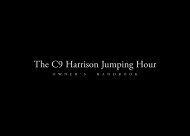C6 Kingfisher Diver-Pro - Christopher Ward
C6 Kingfisher Diver-Pro - Christopher Ward
C6 Kingfisher Diver-Pro - Christopher Ward
Create successful ePaper yourself
Turn your PDF publications into a flip-book with our unique Google optimized e-Paper software.
<strong>C6</strong> <strong>Kingfisher</strong> <strong>Diver</strong>-<strong>Pro</strong><br />
O W N E R ’ S H A N D B O O K
Time on your side...<br />
Your <strong>Christopher</strong> <strong>Ward</strong> watch has been designed and engineered by highly talented craftspeople to<br />
ensure not only accurate and precise timekeeping but also to bring a real pride of ownership that<br />
only luxury items of the highest quality can ever hope to deliver.<br />
You have made an investment, a good one, and the aim of this handbook is to help you make the<br />
most of that investment during what I hope will be a lifetime of ownership.<br />
<strong>Christopher</strong> <strong>Ward</strong>
Caring for your <strong>Christopher</strong> <strong>Ward</strong> quartz watch<br />
Your <strong>C6</strong> <strong>Kingfisher</strong> <strong>Diver</strong>-<strong>Pro</strong> is constructed from the finest components and materials available<br />
including one of Switzerland’s finest quartz movements.<br />
As with all watches of this quality, with just a little care, it has the potential to become an heirloom<br />
piece giving further joy to future generations.<br />
Here are a few hints to help keep your watch working perfectly over the years:<br />
• Although the battery in your watch may last longer, we recommend you have it changed every<br />
2/3 years by a reputable watch repairer.<br />
• At the same time as having the battery changed it makes sense to have the watch repairer clean<br />
and lubricate your watch as necessary.<br />
• Make sure the crown is screwed down fully before putting the watch into water. Adhere to<br />
the water resistance ratings towards the end of the handbook to prevent water getting to the<br />
movement which could result in a very costly repair or the need for a replacement movement.<br />
• Your watch is shock resistant to minor impacts but dropping from height onto a hard surface<br />
may damage the movement.
Should you need a replacement part - don’t worry, we keep stocks of spare parts for years, even for<br />
discontinued models. It’s all part of the <strong>Christopher</strong> <strong>Ward</strong> service.<br />
Finally, don’t forget our CW360° Care <strong>Pro</strong>gramme allows you to return your watch absolutely free,<br />
for any reason, and with no quibbles, for up to 60 days after purchase and we also guarantee your<br />
movement for up to 60 months, so long as it is regularly serviced. After all, why shouldn’t you enjoy<br />
peace of mind as much as you enjoy your watch?<br />
Your watch should also be thoroughly rinsed in fresh water after immersion in salt water.<br />
You must always ensure the crown is fully tightened before any use in water.
The <strong>C6</strong> <strong>Kingfisher</strong> <strong>Diver</strong>-<strong>Pro</strong><br />
Features<br />
5 jewel Swiss quartz movement<br />
4.5mm thick scratch-resistant convex sapphire<br />
crystal glass with anti-reflective coating<br />
Water resistant to 300m (30 atm)<br />
Lockable deployment clasp with wetsuit adjustment<br />
Screw-in crown<br />
2 piece uni-directional bezel<br />
Superluminova filled indices, bezel marker and<br />
hands<br />
Date display<br />
Screw-in case back with engraved NDL (No<br />
Decompression Limit) table, and unique serial<br />
number<br />
Sand blasted, satin brushed and IPK finished solid<br />
316L stainless steel case<br />
Technical Data<br />
Diameter: 42mm<br />
Height: 13.0mm<br />
Weight: 80g - 160g<br />
Case: 316L Stainless steel<br />
Calibre: Ronda 715<br />
Battery type: 371<br />
Accuracy: +20 / -10 seconds per month<br />
Magnetic 18.8 Oe<br />
resistance:
Description of the display and control buttons<br />
Display elements<br />
Control buttons<br />
Minute Hand<br />
Hour Hand<br />
Crown<br />
Second Hand<br />
Date<br />
Bezel
Setting the time / date<br />
1 2<br />
For a higher water resistance your crown is of<br />
the screw-in type. To get to position 1 , turn the<br />
crown anti-clockwise until it releases itself.<br />
Pull gently into position 1 . For rapid date<br />
correction, turn in a clockwise direction.<br />
From position 1 , pull the crown to position 2<br />
and adjust the time setting in either a clockwise<br />
or anti-clockwise direction.<br />
After adjusting to the correct time ensure that<br />
the crown is screwed back in until flush with the<br />
case in order that water resistance is maintained.<br />
Please note:<br />
Date correction should not be carried out between<br />
20.00 hr and 02.00 hr as the watch gearing will<br />
already be aligning itself to change the date. The<br />
crown should always be screwed in after adjustment.
A note of caution<br />
A dive watch of this type is NO substitute for a dive computer when diving and should<br />
only be used as a backup device.<br />
Always make sure that you use the proper instrumentation when diving including a depth gauge,<br />
submersible pressure gauge, timer, and have access to decompression tables whenever diving as illustrated<br />
later in this chapter.<br />
The NDL Table engraved on the back is designed for backup purposes and should only be used by<br />
certified divers or individuals under the supervision of a certified scuba instructor. Misuse of this<br />
product may result in serious injury or death.<br />
Note. Because people differ in their susceptibility to decompression sickness, No Decompression<br />
Table can NOT guarantee that decompression sickness will never occur even though you dive<br />
within the table limits.
Using NDL and recreational dive planner tables<br />
The purpose of Recreational Dive Planner Tables is to make all dives no decompression dives.<br />
<strong>Pro</strong>per planning assures that all dives, single or repetitive, are within the no decompression limits by<br />
controlling the length of the dive, the depth of the dive, and the surface interval between dives.<br />
Use of Recreational Dive Planner Tables require having and using an accurate depth gauge, an<br />
underwater timer, a slate and pencil and the planner itself. You need to know the depth of each<br />
dive so you can determine the maximum time allowed, or you must limit your depth to a specific<br />
planned maximum depth.<br />
Always consult Recreational Dive Planner Tables (eg. PADI or BSAC) before each dive to be sure<br />
you know your no decompression limit. Note the time on an underwater slate and carry it with you<br />
and also note the no decompression limit for the next deeper depth, in case you accidentally exceed<br />
your limit. Remember that your deepest dive is always first, and each successive dive is to an equal<br />
or shallower depth than the preceding dive. If your time limits are short, consider making a shallower<br />
dive to permit more time.<br />
As shown on Page 10, a Recreational Dive Planner Table is actually three tables linked together.<br />
Each of the three tables provides information for planning dives within accepted nitrogen levels.
The <strong>C6</strong> <strong>Kingfisher</strong> <strong>Diver</strong>-<strong>Pro</strong> NDL table<br />
No decompression limit (NDL) is the maximum time that can be spent at a depth before<br />
decompression stops are required. This is sometimes also known as “no-stop time”. The NDL<br />
table on the back of your <strong>Kingfisher</strong> <strong>Diver</strong>-<strong>Pro</strong> will give you a reading of your “no-stop time” at any<br />
known depth for your first dive only.
Reading the NDL table<br />
Example 1:<br />
On your first dive you know that the maximum<br />
depth you plan to dive to is 90ft. From the table<br />
one can see that the maximum time before a<br />
decompression stop is required at this depth is 25<br />
minutes.<br />
!<br />
Always be conservative and avoid using the<br />
maximum limits provided.<br />
Plan repetitive dives so each successive dive<br />
is to a shallower depth.<br />
Always plan your deepest dive first.<br />
Repetitive dives MUST be calculated on a<br />
certified recreational or professional dive<br />
plan table.
Example 2:<br />
On your first dive you know that the maximum<br />
depth you plan to dive to is 60ft. From the table<br />
one can see that the maximum time before a<br />
decompression stop is required at this depth is<br />
55 minutes.
The bezel<br />
Bezel marker<br />
From Example 2 we know that the maximum<br />
“no-stop time” is 55 minutes.<br />
The time at the surface immediately before the dive<br />
is 10.08am.<br />
However the bezel marker is at the 12.00 hr<br />
position.<br />
1<br />
Move the bezel marker so that it aligns with<br />
the 8 minute position.
No decompression<br />
limit<br />
Start of dive<br />
2<br />
You can now read that the 55 minute no<br />
decompression limit will occur at 3 minutes past<br />
the next hour.<br />
Please note:<br />
It is always useful and best practice to make a<br />
note on a dive slate before entering the water and<br />
to carry a set of dive tables should the dive plan<br />
change during the course of the dive. A safety stop<br />
for 3 to 5 minutes at 15ft is recommended at the<br />
end of all dives. A safety stop for 3 minutes at 15ft<br />
is required any time you come within 3 pressure<br />
groups of a no decompression limit, and for any<br />
dive to a depth of 100ft or deeper.
Fitting the bracelet<br />
If you find the bracelet needs adjusting to your wrist we recommend you have it re-sized by a<br />
reputable watch repairer or jeweller. Most local jewellers will either do this for free or perhaps make<br />
a nominal charge for what is a job that should only take a few minutes. It is always best to be<br />
present so a comfortable fit is achieved.<br />
Establishing the length of the bracelet<br />
Place the watch with its separated bracelet on your wrist and estimate the number of links you need<br />
to remove. If you need to remove several links, try to keep the numbers removed from both halves<br />
of the bracelet as equal as possible to ensure that the clasp remains roughly in the middle of your wrist.<br />
Press<br />
To open your bracelet simply press either side of<br />
the clasp to release as shown.
The quick-release butterfly clasp<br />
The strap versions of the <strong>C6</strong> <strong>Kingfisher</strong> <strong>Diver</strong>-<strong>Pro</strong> use quick-release butterfly clasps and are made<br />
of silicon rubber. If you need to adjust the length of your silicon strap follow the same principles as<br />
specified on page 17 of this handbook.<br />
Please note that the deployment clasp has three springbar settings. The watch should be set to the<br />
innermost setting for normal use and to the outermost setting for a looser fit to fit over a wetsuit.<br />
Further details can be found on our website at www.christopherward.co.uk.<br />
To open the quick release butterfly clasp pull back the locking lever and press both buttons.<br />
Wrist Setting<br />
Wetsuit<br />
Setting<br />
Locking Lever
Water resistance<br />
Please note. these are only guidelines but we strongly urge you to adhere to them to retain the<br />
integrity of your watch. If you have any queries regarding this please contact us direct.<br />
1 ATM<br />
(10 Metres)<br />
3 ATM<br />
(30 Metres)<br />
5 ATM<br />
(50 Metres)<br />
10 ATM<br />
(100 Metres)<br />
30 ATM<br />
(300 Metres)<br />
50 ATM<br />
(500 Metres)<br />
Safe to wear your<br />
watch while<br />
washing your<br />
hands with tap<br />
water.<br />
Washing your car<br />
and or general<br />
hosepipe usage.<br />
Water resistant to<br />
most household<br />
shower units.<br />
Safe to use while<br />
snorkelling in open<br />
water, it is not<br />
advisable to dive<br />
with your watch.<br />
Ideal for<br />
experienced divers<br />
and, in general,<br />
anybody practising<br />
scuba-diving.<br />
<strong>Pro</strong>fessional divers,<br />
experienced<br />
prolonged exposure<br />
underwater.<br />
NB. To safeguard watch movement please ensure the crown is, at all times, secured correctly.
Keeping in touch with <strong>Christopher</strong> <strong>Ward</strong>...<br />
From small beginnings just a few short years ago (our first workshop was actually a refurbished<br />
chicken shed!), <strong>Christopher</strong> <strong>Ward</strong> has won a worldwide following for his eponymous watch brand<br />
and can justifiably claim to manufacture the most affordable luxury watches in the world.<br />
For many, the philosophy behind the brand, trying to put luxury watches within the reach of<br />
everyone, is as attractive as the watches themselves as is the very open approach of the business<br />
which means that Chris and the team spend a lot of time communicating personally with our<br />
customers - many of whom have become friends.<br />
As the owner of a <strong>Christopher</strong> <strong>Ward</strong> watch, if ever you need to get hold of us we are at your service.<br />
We have listed some useful contact details on the back cover.<br />
There is also always something new going on at our website at www.christopherward.co.uk<br />
and, if you haven’t already discovered the independent forum dedicated to our brand at<br />
www.christopherwardforum.com we would recommend a visit. Informative and fun, it’s a great<br />
place to hear the unexpurgated view of <strong>Christopher</strong> <strong>Ward</strong> of London!
















